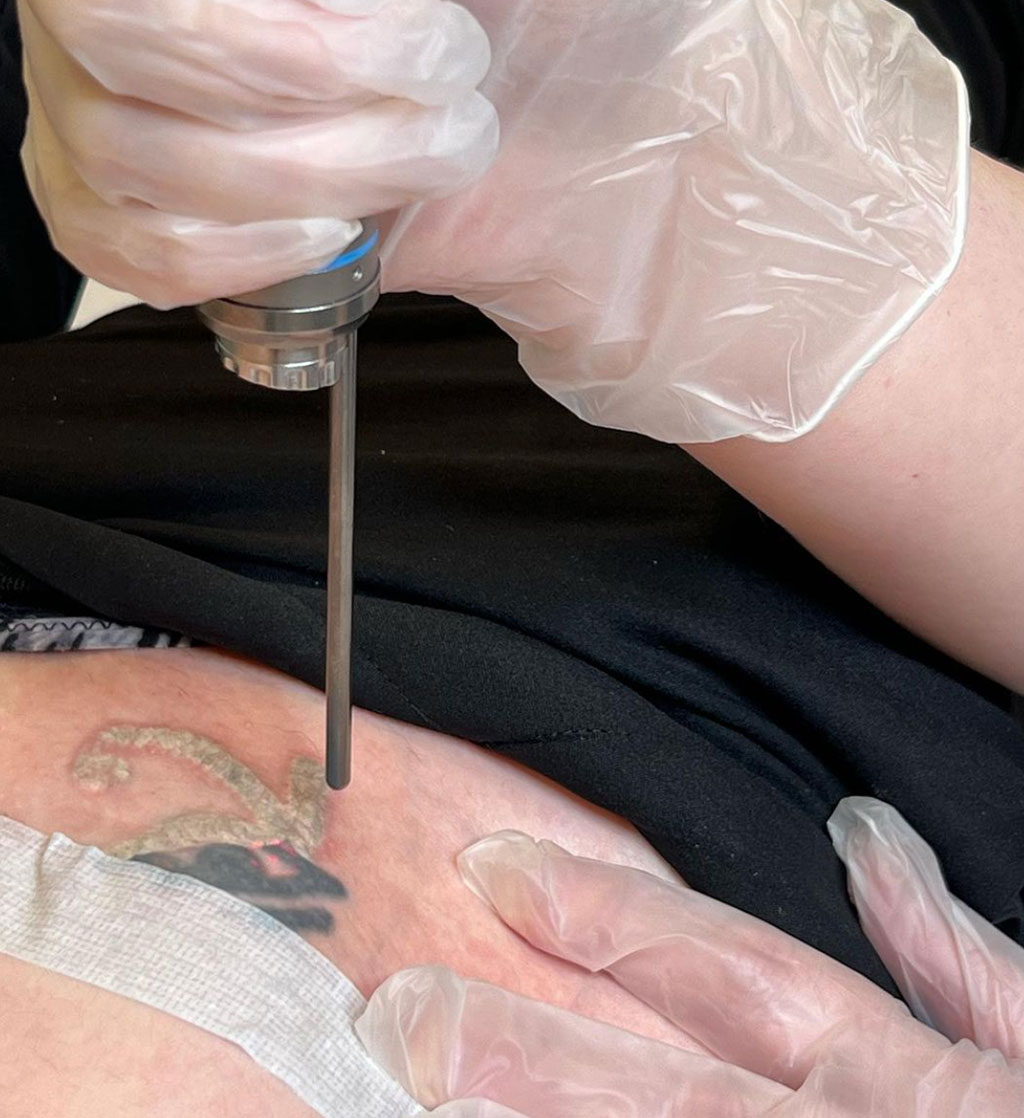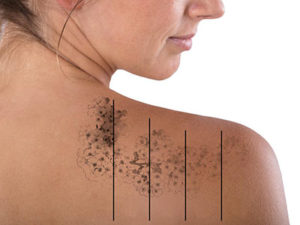Laser tattoo removal is a popular, non-invasive cosmetic procedure that uses high-powered lasers to break down the pigments in a tattoo, allowing the body to naturally absorb and eliminate them.
There are several factors to consider before undergoing laser tattoo removal, including the size and colour of the tattoo, as well as the individual’s skin type and overall health. Below, we’ll explore the basics of laser tattoo removal and what you can expect from the procedure.
How does laser tattoo removal work?
Laser tattoo removal uses high-powered lasers to break down the pigments in a tattoo. The laser energy is absorbed by the ink particles, which then heat up and shatter into smaller pieces. Your body’s immune system recognises these smaller ink particles as foreign substances and naturally eliminates them over time.
The first step in the laser tattoo removal process is to schedule a consultation with a trained professional. During this consultation, your skin type, overall health and the tattoo’s size, location and colour will be assessed. This information will be used to create a personalised treatment plan for you.
During the procedure, the laser will be directed at the tattooed area. You may experience slight discomfort. The length of the procedure will depend on the size and complexity of the tattoo, but most sessions last between 10 and 30 minutes.
After each session, the treated area will be dressed, and you’ll get instructions on how to keep it clean to prevent infection. You also have to avoid sun exposure and certain activities that could irritate the treated area.
Number of sessions
It is important to note that laser tattoo removal is not a one-time procedure. Most tattoo removals will require several sessions spaced several weeks apart to achieve optimal results. The number of sessions required for your laser tattoo removal will depend on several factors, such as the size and colour of your tattoo and your skin type and overall health. In general, most tattoos require multiple sessions to achieve optimal results.
For smaller tattoos with less ink density, it may be possible to achieve satisfactory results in as few as 2 to 4 sessions. However, larger tattoos or those with more ink density may require 8 to 10 or more sessions to achieve satisfactory fading or removal.
Your local Evolution Laser Clinic will create a personalised treatment plan that takes into account your unique needs and goals. They will monitor your progress throughout the sessions and adjust the treatment plan as needed. Remember to follow their instructions carefully and take proper care of the treated area between sessions to achieve the best possible results.
How much does laser tattoo removal cost?
The average cost per session for laser tattoo removal is typically between $200 and $500. However, keep in mind that most tattoos require multiple sessions to achieve optimal results, which means the total cost can add up over time. Some of our clinics offer package deals or discounts for multiple sessions, so be sure to ask about any available options.
Additionally, the cost of your laser tattoo removal fluctuates depending on several factors, such as the size and complexity of the tattoo, the number of sessions required. Generally speaking, smaller tattoos with less ink density will cost less to remove than larger tattoos with more ink density.
Laser tattoo removal aftercare
Proper aftercare is crucial to ensure the best possible results from your laser tattoo removal. After each session, your laser therapist will provide specific instructions on how to care for the treated area.
Here are some general aftercare tips to keep in mind:
- Keep the treated area clean and dry. Avoid submerging the area in water, such as in a bath or swimming pool, and do not scrub or pick at the area.
- Apply an antibiotic ointment and cover the area with a sterile bandage. Doing so will help prevent infection and protect the area from irritation.
- Avoid sun exposure. The sun can cause hyperpigmentation or darkening of the skin, which can cause adverse effects.
- Avoid activities that could cause irritation, such as exercise or heavy lifting. This can cause friction and discomfort, which can slow down the healing process.
It’s important to be patient and give your body time to naturally eliminate the ink particles broken down by the laser. Remember to attend all scheduled sessions and follow your healthcare provider’s instructions carefully to achieve the best possible results. If you have any concerns or questions about aftercare, don’t hesitate to contact your local clinic for guidance.
Laser tattoo removal results — what to expect
After several sessions of laser tattoo removal, you can expect to see significant fading or complete removal of your tattoo. However, keep in mind that complete removal is not always possible, and some tattoos may only fade partially.
The treated area may be slightly swollen, red or tender after each session, but these side effects should subside within a few days. You may also notice some scabbing or crusting over the treated area, which is a normal part of the healing process.
Does laser tattoo removal leave scars?
In most cases, laser tattoo removal does not leave scars if the procedure is performed by a trained professional using the proper equipment and technique. The laser is designed to target the ink particles in your tattoo without damaging the surrounding skin, and your body’s natural healing process typically minimises any potential scarring.
However, there is a small risk of ending up with a tattoo removal scar if the treated area becomes infected or if you do not follow proper aftercare instructions. This is why it’s crucial to keep the treated area clean and dry and avoid activities that could irritate or damage the area.
Additionally, some people may be more prone to scarring than others, particularly those with a history of keloid or hypertrophic scarring. It’s important to discuss any concerns about scarring with your healthcare provider before undergoing laser tattoo removal.
Before and after laser tattoo removal
Before the tattoo removal process, the tattooed area may appear dark, vibrant and well-defined. The ink may be visible through your skin and may be difficult to cover with makeup or clothing.
After several sessions of laser tattoo removal, the tattooed area may appear lighter and less defined. The ink particles will have been broken down and absorbed by your body, resulting in significant fading or complete removal of the tattoo, depending on the size and complexity of the tattoo and your skin type and overall health. The treated area may also appear slightly swollen, red or tender after each session, but these side effects should subside within a few days.
Remember, laser tattoo removal results can vary, and you may see more or less fading than you originally assumed. To give you a better idea, below is an example image of before and after laser tattoo removal sessions.
Laser tattoo removal — FAQs
If you’re considering laser tattoo removal, you may have a lot of questions about the process. In this FAQ section, we’ll answer some of the most common questions about laser tattoo removal, including what to expect during the procedure, how much it costs, whether it’s painful and more.
1. How do I prepare for laser tattoo removal?
To prepare for laser tattoo removal, you should:
- Avoid sun exposure to the treated area for at least two weeks before the procedure.
- Avoid using skincare products or medications that can increase your skin’s sensitivity to the sun.
- Shave the area around the tattoo to allow for better access to the skin.
- Avoid alcohol and aspirin-containing products for at least 24 hours before the procedure.
- Follow any other specific instructions provided by your healthcare provider.
2. How long does laser tattoo removal take?
Generally speaking, most tattoos require multiple sessions spaced several weeks apart to achieve optimal results. Each session typically lasts between 10 and 30 minutes, depending on the size and complexity of the tattoo.
3.How many sessions to remove the tattoo will I need?
This answer will vary depending on your unique situation. Smaller, less complex tattoos can take as few as 2 to 4 sessions, while larger ones can take up to 10 or more. Your health and the tattoo’s ink density will also factor in.
4. Can I get it anywhere on my body?
In most cases, laser tattoo removal can be performed on any area of your body where you have a tattoo. However, the effectiveness of the treatment may vary depending on the location of the tattoo and your skin type and overall health. Areas with good blood flow, such as the arms and legs and torso, generally respond well to laser tattoo removal. Areas with poor blood flow, such as the hands and fingers and feet and toes, may require more sessions to achieve optimal results.
5. Does tattoo laser removal really work?
Yes, laser tattoo removal can be an effective way to fade or remove unwanted tattoos. The laser works by breaking up the ink particles in the tattoo, which are then absorbed and eliminated by the body’s immune system. However, it’s important to note that complete removal is not always possible, and some tattoos may only fade partially.
Evolution Laser Clinic offers high-quality laser tattoo removal in Sydney and the surrounds
If you’d like to know more about the laser tattoo removal process and what to expect, contact us at Evolution Laser Clinic. Our staff of highly trained professionals use the latest techniques and equipment to ensure our clients get next-level results with their tattoo removal. No matter how large or small your tattoo is, we’re happy to set up a consultation to help you figure out the best solution for your tattoo removal needs.















